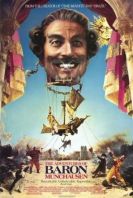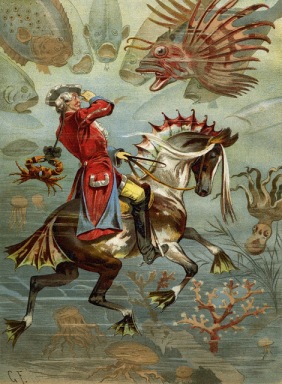You are currently browsing the tag archive for the ‘medicine’ tag.
 Yesterday I watched Terry Gilliam’s 1988 film, The Adventures of Baron Munchausen for the first time. It stars John Neville as the Baron and Eric Idle as Berthold. It’s a fantastic film, completely absorbing and surreal with amazing sets, stunts and action which look so impressive compared to today’s CGI alternatives.
Yesterday I watched Terry Gilliam’s 1988 film, The Adventures of Baron Munchausen for the first time. It stars John Neville as the Baron and Eric Idle as Berthold. It’s a fantastic film, completely absorbing and surreal with amazing sets, stunts and action which look so impressive compared to today’s CGI alternatives.
With spectacle comes criticism however as, having done some research on the film, it is clear that Gilliam’s films are notorious for being dangerous and traumatic for the cast and expensive to film – watching this one, you can see why. Sarah Polley, who played 9-year-old Sally, said:
It definitely left me with a few scars … It was just so dangerous. There were so many explosions going off so close to me, which is traumatic for a kid whether it’s dangerous or not. Being in freezing cold water for long periods of time and working endless hours. It was physically grueling and unsafe.
There were disputes surrounding the production and in the end it received limited distribution and only made $8 million in the US box office. Nonetheless, I really recommend it as it is so spectacular and engrossing – and it’s currently on Netflix!
It really made me think about the stories that inspired the film and specifically the real Hieronymus Carl Friedrich Baron von Münchhausen. The real Baron was a German nobleman, born in 1720, who became famous for telling stories about his adventures.
Münchhausen moved to Russia where he rose to the rank of Rittmeister (Captain) in the Russian cavalry and fought in the Russo-Turkish War. He was known as a amiable and truthful man, however after he retired he gained a reputation as a teller of extraordinary stories about his time in Russia. He told these tall tales at social gatherings as entertainment and perhaps to poke fun at his contemporaries’ love for rationality. This theme certainly runs through the film as the Baron exclaims he is tired of the world because:
It’s all logic and reason now. Science, progress, laws of hydraulics, laws of social dynamics, laws of this, that, and the other. No place for three-legged cyclops in the South Seas. No place for cucumber trees and oceans of wine. No place for me.
Bearing in mind this relatively simple story of the Baron’s real life, it is amazing that his stories had such far-reaching effects. He began to be fictionalized before he even died, when 17 of his stories made it into the Vademecum fur lustige Leute between 1781 and 1783. In 1785 these were translated into English, as Baron Munchausen’s Narrative of his Marvellous Travels and Campaigns in Russia by Rudolf Erich Raspe, and over the next century his stories were expanded and republished multiple times, becoming very popular.
It is likely that folk and fairy tales made it into the narratives that were attributed to him, so we cannot know how much of the material is really his. He was apparently very annoyed that his name was associated with these tall tales as he was given the name Lügenbaron or Baron of Lies.
Still it was way too late to stop public enthusiasm for the fictionalized Baron and the character and stories were replayed again and again on the stage, on radio, television, in films and even in video games. Some of the most famous stories that were in Raspe’s 1785 book and in Gilliam’s film include the Baron’s journey to the moon in a hot air balloon, his meeting with Venus and his escape after being swallowed by a giant fish.
Raspe’s book is available to read on Project Gutenberg and to listen to on Librivox.
Lastly, Münchausen Syndrome was named directly after the fictional Baron. In an article published in 1951, British doctor Richard Asher proposed the name Münchausen Syndrome for cases of patients lying about their illnesses, arguing that:
Like the famous Baron von Munchausen, the persons affected have always travelled widely; and their stories, like those attributed to him, are both dramatic and untruthful. Accordingly, the syndrome is respectfully dedicated to the baron, and named after him
He was criticised for this, since other physicians felt the name trivialised the disorder and downplayed the dangers associated with it and also linked it to a real man who did not suffer from the condition. Clearly though the name has stuck and is now in common usage.
Dr Michael Mosley is a wonderful programme maker who is responsible for several other great documentaries I’ve mentioned before, including Medical Mavericks, The Story of Science, Frontline Medicine and several episodes of Horizon. Now he’s presenting a new three-part series called Pain, Pus & Poison: The Search for Modern Medicines.
The first episode deals with the search for medicines to relieve pain. Several of the stories he presents have been presented in his previous programmes, however it’s always nice to have an update. He tells the story of the development of ether for use in operations, which was marked by conflict between William T. G. Morton, who performed a painless tooth extraction with the drug in 1846, and Henry Jacob Bigelow, who arranged a demonstrations where ether was used in an operation on a patient’s neck tumor.
He also explains how the drugs Heroin and Aspirin were developed simultaneously and initially Heroin was selected as the preferred drug and marketed successfully by Bayer AG. Aspirin slowly grew in popularity as Heroin’s addictive properties began to cause concern and Aspirin became one of the most popular drugs in the world.
Mosley tests the medicines he is talking about on himself, which really brings his programmes to life, proving he’s really serious about what he’s talking about, or at least eager to get high! In this first episode, he conducts several staggering experiments, including rubbing cocaine into his eye before poking it and having himself intravenously drugged with sodium thiopental, to test its ability as a truth serum.
The show is incredibly engaging, and I particularly enjoy his explanations of how the painkillers actually function in the body, something I always wonder about when taking them! The episode concludes with a celebration of morphine, the drug that has endured for 200 years despite huge developments in medicine.
Episode 1: Pain is on iPlayer now, as is the next episode, Pus.
In the last couple of weeks I have been craving modern history documentaries, particularly those concerned with British and American politics. The next few documentary posts contain a few good ones I’ve discovered during my browsing.
Blair: The Inside Story
Several documentaries were made in 2007, on the 10th anniversary of Tony Blair becoming Prime Minister, including this one and The Blair Years. Both are on YouTube and are worth watching. I find this period very interesting as it is the only one I remember personally – my formative years were during Blair’s government. Blair: The Inside Story is presented by award-winning political journalist Michael Cockerell and is a generally well-balanced look back at Blair’s time in office. It contains fascinating interviews with key players in government, as well as revealing footage of Tony Blair inside Number 10, filmed by Cockerell himself.
The NHS: A Difficult Beginning
This documentary explains how the National Health Service was created and the difficulties it overcame to get established. it was broadcast on BBC4 in 2009 to celebrate the 60th birthday of the NHS. It tells the story of Nye Bevan, Labour’s minister of health, who pushed the reforms through despite enormous opposition from the Tory Party, the press and most importantly the medical establishment. This is a fascinating insight into some often overlooked areas of modern history – definitely worth a watch.
Andrew Marr’s The Making of Modern Britain
This documentary was first broadcast in 2009 and cover the period in British history from the death of Queen Victoria to the end of the Second World War. it was made as a follow-up to A History of Modern Britain which covered the period after the Second World War and is unfortunately not on YouTube. It covers a very interesting period which is often neglected in popular histories and Marr continually makes the point that the Britain of today is closely connected to the developments of this period. He’s a great documentary maker and keeps things light and entertaining even when dealing with depressing and controversial topics.
Blood and Guts – A History of Surgery
This is a brilliant set of five programmes which I missed when they were first broadcast in 2008. They are presented by Michael J. Mosley, a medical doctor and journalist, and he is a really engaging speaker who is never scared of getting involved in experiments to show us the old medical treatments of the past. The programmes cover some really fascinating topics such as brain and heart surgery, plastic surgery and transplants. He has made many other programmes for TV and radio including Medical Mavericks, wchich explores the history of self-experimentation and The Making of Modern Medicine on BBC Radio 4. Other examples of his work can be found on Youtube.






Recent Comments